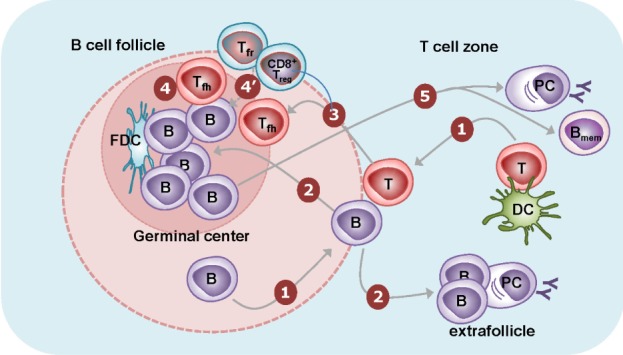Figure 1.

B cell responses to T-dependent antigens. (1) Naïve CD4+ T cells are activated by dendritic cells presenting cognate antigens in the T cell zones. They transiently express CXCR5 and migrate to the T-B border. B cells recognize their cognate antigens through surface Ig and migrate to the T-B border. In the T-B border, activated CD4+ T cells interact with B cells in an antigen-specific manner, termed "linked recognition." (2) Activated B cells then migrate either to B cell follicles or to the T cell zone. The latter B cells form extrafollicularly and differentiate into short-lived plasma cells with few somatic mutations. (3) Some of the activated CD4+ T cells can acquire characteristics of the Tfh cell lineage and stably express CXCR5. These Tfh cells migrate to the B cell follicle. (4) The activated B cells in B cell follicles are further stimulated by follicular dendritic cells and Tfh cells for multiple rounds. Follicular dendritic cells provide antigens to B cells, leading to the clonal selection of B cells that express high-affinity Ig on their surface. Tfh cells provide IL-21 and costimulation in order to induce the proliferation of B cells, isotype switching, and somatic mutation. The massive B cell expansion and differentiation lead to the formation of germinal centers in the follicle. (4') Tfr cells and CD8+ Treg cells are thought to suppress this germinal center reaction. (5) The germinal center reaction induces the differentiation of isotype-switched affinity-matured B cells into memory B cells or into long-lived plasma cells.
